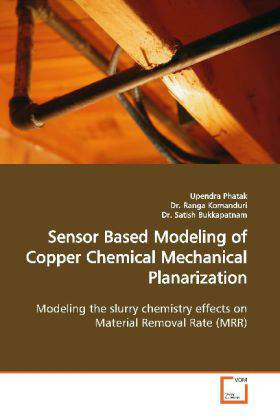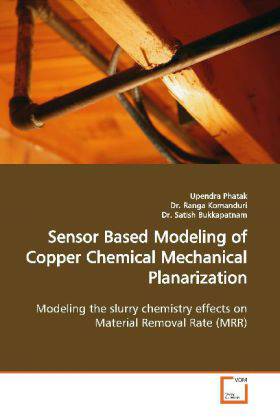
- Afhalen na 1 uur in een winkel met voorraad
- Gratis thuislevering in België vanaf € 30
- Ruim aanbod met 7 miljoen producten
- Afhalen na 1 uur in een winkel met voorraad
- Gratis thuislevering in België vanaf € 30
- Ruim aanbod met 7 miljoen producten
Zoeken
Sensor Based Modeling of Copper Chemical Mechanical Planarization
Modeling the slurry chemistry effects on Material Removal Rate (MRR)
Upendra Phatak
Paperback | Engels
€ 58,45
+ 116 punten
Omschrijving
The variations in slurry chemistry parameters
including pH, concentrations of complexing and
corrosion inhibiting agents, and slurry flow rates
as well as average MRR in Cu-CMP process are modeled
using features from two vibration sensors (one wired
and the other wireless accelerometer). The study is
perhaps one of the first efforts to use wireless
vibration sensors for real-time monitoring of MRR
and the chief slurry chemistry parameters in CMP. We
hope that this work will lead to the advent of
physics-based process-machine interaction (PMI)
models that can be used to delineate the various
process behaviors, which in turn can be used to
select vibration signal features that are more
sensitive to variations in MRR and other quality and
performance variable of the CMP process. The study
has delineated the joint (i.e., statistical
interaction) effects of various slurry components on
MRR in Cu-CMP. In specific, the joint effects of the
complexing agent with other input parameters, such
as pH and flow rate (i.e., two-way interactions) on
MRR have been found to be significant.
including pH, concentrations of complexing and
corrosion inhibiting agents, and slurry flow rates
as well as average MRR in Cu-CMP process are modeled
using features from two vibration sensors (one wired
and the other wireless accelerometer). The study is
perhaps one of the first efforts to use wireless
vibration sensors for real-time monitoring of MRR
and the chief slurry chemistry parameters in CMP. We
hope that this work will lead to the advent of
physics-based process-machine interaction (PMI)
models that can be used to delineate the various
process behaviors, which in turn can be used to
select vibration signal features that are more
sensitive to variations in MRR and other quality and
performance variable of the CMP process. The study
has delineated the joint (i.e., statistical
interaction) effects of various slurry components on
MRR in Cu-CMP. In specific, the joint effects of the
complexing agent with other input parameters, such
as pH and flow rate (i.e., two-way interactions) on
MRR have been found to be significant.
Specificaties
Betrokkenen
- Auteur(s):
- Uitgeverij:
Inhoud
- Aantal bladzijden:
- 132
- Taal:
- Engels
Eigenschappen
- Productcode (EAN):
- 9783639133714
- Uitvoering:
- Paperback
- Afmetingen:
- 220

Alleen bij Standaard Boekhandel
+ 116 punten op je klantenkaart van Standaard Boekhandel
Beoordelingen
We publiceren alleen reviews die voldoen aan de voorwaarden voor reviews. Bekijk onze voorwaarden voor reviews.











